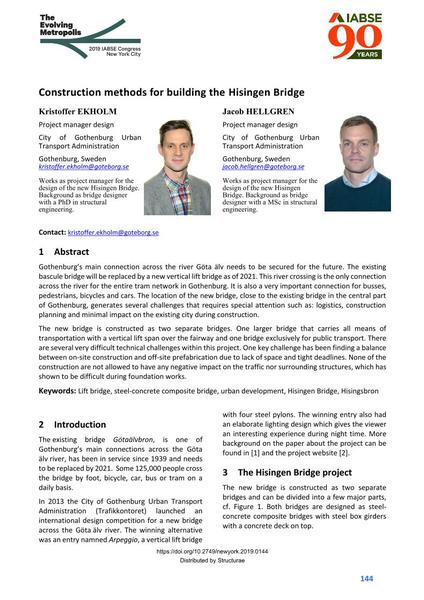Construction methods for building the Hisingen Bridge

|
|
|||||||||||
Bibliografische Angaben
| Autor(en): |
Kristoffer Ekholm
(City of Gothenburg Urban Transport Administration)
Jacob Hellgren (City of Gothenburg Urban Transport Administration) |
||||
|---|---|---|---|---|---|
| Medium: | Tagungsbeitrag | ||||
| Sprache(n): | Englisch | ||||
| Tagung: | IABSE Congress: The Evolving Metropolis, New York, NY, USA, 4-6 September 2019 | ||||
| Veröffentlicht in: | The Evolving Metropolis | ||||
|
|||||
| Seite(n): | 144-148 | ||||
| Anzahl der Seiten (im PDF): | 5 | ||||
| DOI: | 10.2749/newyork.2019.0144 | ||||
| Abstrakt: |
Gothenburg’s main connection across the river Göta älv needs to be secured for the future. The existing bascule bridge will be replaced by a new vertical lift bridge as of 2021. This river crossing is the only connection across the river for the entire tram network in Gothenburg. It is also a very important connection for busses, pedestrians, bicycles and cars. The location of the new bridge, close to the existing bridge in the central part of Gothenburg, generates several challenges that requires special attention such as: logistics, construction planning and minimal impact on the existing city during construction. The new bridge is constructed as two separate bridges. One larger bridge that carries all means of transportation with a vertical lift span over the fairway and one bridge exclusively for public transport. There are several very difficult technical challenges within this project. One key challenge has been finding a balance between on-site construction and off-site prefabrication due to lack of space and tight deadlines. None of the construction are not allowed to have any negative impact on the traffic nor surrounding structures, which has shown to be difficult during foundation works. |
||||
| Stichwörter: |
Stadtentwicklung Stahl-Beton-Verbundbrücke
|
||||
